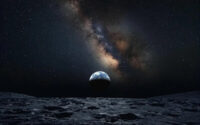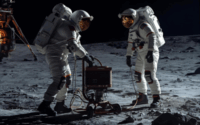September 22-28, 2025 / Vol 44, No 38 / Hawai`i Island, USA
Lunar Broadcast Precursor: Terrestrial Edition
IMAP, SWFO-L1 and Carruthers Set to Probe Cosmic Boundaries

NASA Interstellar Mapping and Acceleration Probe (IMAP), Space Weather Follow-On Lagrange-1 (SWFO-L1), and Carruthers Geocorona Observatory launch September 23. After arriving at Sun-Earth L1 Lagrange point, ~1.6 million km toward Sun from Earth, these spacecraft are expected to revolutionize understanding of Sun heliosphere and Earth exosphere, both protective of life on Earth. 900kg IMAP has instrument “Ultra” to map the heliosphere, envisioned as a protective bubble around the entire Solar System guarding against cosmic radiation, emanating from the Sun gravitational field. Others of its 10 instruments will study particles arriving from interstellar space that reveal galaxy composition, possibly life origins, and interact with heliosphere / solar wind. 377kg SWFO-L1 is expected to give ~30min warning to astronauts / spacecraft of harmful radiation. 240kg Carruthers Geocorona Observatory is named after George Carruthers PhD, inventor of first telescope on the Moon, used by John Young to image with UV the Earth exosphere, a critical shield against solar storms. International Lunar Observatory Association hopes to soon place 2nd lunar telescope. Meanwhile, these 1st satellites operating continuously at L1 will deliver unprecedented data to safeguard technology and astronauts and help us understand cosmic forces protecting Earth. (Image Credit: NASA)
NASA Unveils 2025 Astronaut Class and Previews Artemis II Moon Mission

From 8,000+ applicants, the new cohort—following the 2021 class of 10 diverse STEM experts—will train at Johnson Space Center for lunar landings and Mars missions. Expect physicians studying space biology, engineers mastering lunar tech, and pilots, all shaping the Artemis mission. The Astronauts debut September 22 at 12:30 EDT, live on NASA+, YouTube and X. On September 23, two news conferences highlight Artemis II. At 11:00 EDT, Mission Manager Matt Ramsey previews the 10-day, 1,090,000 km lunar flyby, launching NET April 2026 via SLS rocket (79.7 metric tons to low lunar orbit) and Orion spacecraft. At 13:00 EDT, Orion Deputy Debbie Korth details science and tech, including 4 cabin monitors mapping 1.5 mGy/day radiation beyond Van Allen belts. Commander Reid Wiseman, Pilot Victor Glover, Mission Specialist Christina Koch, and CSA astronaut Jeremy Hansen test a hybrid, free-return trajectory, looping Earth twice at 35,400 kph for lunar slingshot. They deploy 10 CubeSats, including Germany TACHELES, while USB-sized AVATAR organ-chips grow bone marrow to study cosmic ray impacts and saliva tests track immune shifts in 1/6th gravity. September 24 at 10:00 EDT, will be an Artemis II crew news conference, then the Johnson media day—hands-on with mission simulators, Orion mockups and exclusive interviews with astronauts, scientists, and flight directors like Jeff Radigan. (Image Credits: NASA)
HUMANS IN SPACE




First Women Land on the Moon in…
Loading Moon data for your location...
Loading planet data...




